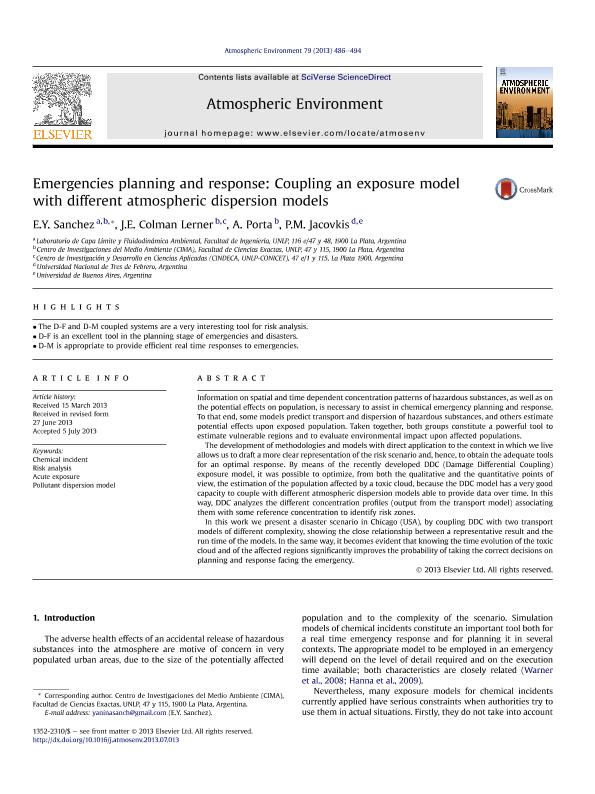Mostrar el registro sencillo del ítem
dc.contributor.author
Sánchez, Érica Yanina

dc.contributor.author
Colman Lerner, Jorge Esteban

dc.contributor.author
Porta, Atilio Andrés

dc.contributor.author
Jacovkis, Pablo Miguel

dc.date.available
2017-08-31T19:16:15Z
dc.date.issued
2013-07
dc.identifier.citation
Sánchez, Érica Yanina; Colman Lerner, Jorge Esteban; Porta, Atilio Andrés; Jacovkis, Pablo Miguel; Emergencies planning and response: Coupling an exposure model with different atmospheric dispersion models; Elsevier; Atmospheric Environment; 79; 7-2013; 486-494
dc.identifier.issn
1352-2310
dc.identifier.uri
http://hdl.handle.net/11336/23382
dc.description.abstract
Information on spatial and time dependent concentration patterns of hazardous substances, as well as on the potential effects on population, is necessary to assist in chemical emergency planning and response. To that end, some models predict transport and dispersion of hazardous substances, and others estimate potential effects upon exposed population. Taken together, both groups constitute a powerful tool to estimate vulnerable regions and to evaluate environmental impact upon affected populations. The development of methodologies and models with direct application to the context in which we live allows us to draft a more clear representation of the risk scenario and, hence, to obtain the adequate tools for an optimal response. By means of the recently developed DDC (Damage Differential Coupling) exposure model, it was possible to optimize, from both the qualitative and the quantitative points of view, the estimation of the population affected by a toxic cloud, because the DDC model has a very good capacity to couple with different atmospheric dispersion models able to provide data over time. In this way, DDC analyzes the different concentration profiles (output from the transport model) associating them with some reference concentration to identify risk zones. In this work we present a disaster scenario in Chicago (USA), by coupling DDC with two transport models of different complexity, showing the close relationship between a representative result and the run time of the models. In the same way, it becomes evident that knowing the time evolution of the toxic cloud and of the affected regions significantly improves the probability of taking the correct decisions on planning and response facing the emergency.
dc.format
application/pdf
dc.language.iso
eng
dc.publisher
Elsevier

dc.rights
info:eu-repo/semantics/openAccess
dc.rights.uri
https://creativecommons.org/licenses/by-nc-sa/2.5/ar/
dc.subject
Chemical Incident
dc.subject
Risk Analysis
dc.subject
Acute Exposure
dc.subject
Pollutant Dispersion Model
dc.subject.classification
Oceanografía, Hidrología, Recursos Hídricos

dc.subject.classification
Ciencias de la Tierra y relacionadas con el Medio Ambiente

dc.subject.classification
CIENCIAS NATURALES Y EXACTAS

dc.title
Emergencies planning and response: Coupling an exposure model with different atmospheric dispersion models
dc.type
info:eu-repo/semantics/article
dc.type
info:ar-repo/semantics/artículo
dc.type
info:eu-repo/semantics/publishedVersion
dc.date.updated
2017-08-30T13:35:17Z
dc.journal.volume
79
dc.journal.pagination
486-494
dc.journal.pais
Países Bajos

dc.journal.ciudad
Ámsterdam
dc.description.fil
Fil: Sánchez, Érica Yanina. Universidad Nacional de La Plata. Facultad de Ciencias Exactas. Departamento de Química. Centro de Investigaciones del Medio Ambiente; Argentina. Consejo Nacional de Investigaciones Científicas y Técnicas; Argentina. Universidad Nacional de La Plata. Facultad de Ingeniería. Departamento de Aeronáutica. Laboratorio de Capa Límite y Fluído Dinámica Ambiental; Argentina
dc.description.fil
Fil: Colman Lerner, Jorge Esteban. Universidad Nacional de La Plata. Facultad de Ciencias Exactas. Departamento de Química. Centro de Investigaciones del Medio Ambiente; Argentina. Consejo Nacional de Investigaciones Científicas y Técnicas. Centro Científico Tecnológico Conicet - La Plata. Centro de Investigación y Desarrollo en Ciencias Aplicadas "Dr. Jorge J. Ronco". Universidad Nacional de La Plata. Facultad de Ciencias Exactas. Centro de Investigación y Desarrollo en Ciencias Aplicadas; Argentina
dc.description.fil
Fil: Porta, Atilio Andrés. Universidad Nacional de la Plata. Facultad de Ciencias Exactas. Departamento de Química. Centro de Investigaciones del Medio Ambiente; Argentina
dc.description.fil
Fil: Jacovkis, Pablo Miguel. Consejo Nacional de Investigaciones Científicas y Técnicas; Argentina. Universidad Nacional de Tres de Febrero; Argentina. Universidad de Buenos Aires; Argentina
dc.journal.title
Atmospheric Environment

dc.relation.alternativeid
info:eu-repo/semantics/altIdentifier/doi/http://dx.doi.org/10.1016/j.atmosenv.2013.07.013
dc.relation.alternativeid
info:eu-repo/semantics/altIdentifier/url/http://www.sciencedirect.com/science/article/pii/S1352231013005347
Archivos asociados
